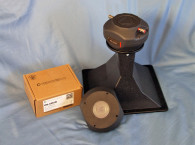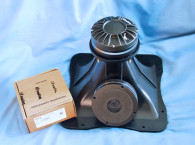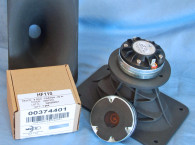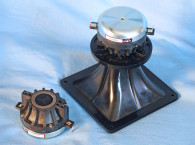




The PD.CD1N has a 25.4 mm (1”) throat diameter and is driven by a PEEK diaphragm/surround with a 44 mm (1.73”) diameter voice coil wound with copper-clad aluminum wire on a Kapton former. Other features include a radial neodymium magnet motor structure, an aluminum three-slot phase plug, nominal 40 W (AES) rated power handling, a 1.6 kHz recommended crossover frequency, and color-coded chrome push terminals. Since Precision Devices does not manufacture horns, I mated the compression driver up to a Faital Pro STH100 Elliptical Tractrix 1” throat 80°H × 40°V aluminum horn with a 1.2 kHz cutoff frequency. Recommended crossover frequency for the PD.CD1N is 1.8 kHz, so a decent match.
I began testing using the LinearX LMS analyzer to produce the 300-point stepped sine wave impedance plot shown in Figure 1. The solid black curve is with the PD.CD1N mounted on the STH100 horn and the dashed blue curve represents the compression driver without the horn. With a 5.93Ω DCR, the minimum impedance of the PD.CD1N/STH100 was 6.8Ω and at 5.6kHz.
For the next set of sound pressure level (SPL) measurements, I free-air mounted the Precision Devices PD.CD1N/STH100 combination without an enclosure and measured both the horizontal and vertical on- and off-axis at 2.83 V/1 m from 0° on-axis to 60° on- and off-axis using the LOUDSOFT FINE R+D analyzer and the G.R.A.S. Sound & Vibration 46BE microphone. Figure 2 displays the on-axis frequency response of the compression driver/horn, which is ±2.7 dB from 1.2 kHz to 12 kHz with no major anomalies.




As previously mentioned, Precision Devices’ recommended crossover frequency for the PD.CD1N is 1.8 kHz with a third-order or higher high-pass filter. Figure 3 shows the 0° to 60° on- and off-axis response in the horizontal plane. Figure 4 displays the normalized horizontal plane response and Figure 5 shows the CLIO Pocket analyzer generated horizontal polar plot (in 10° increments with 1/3 octave smoothing applied).
Figure 6 gives the on- and off-axis response in the vertical plane. Figure 7 depicts the normalized vertical plane response. Figure 8 shows the CLIO Pocket generated polar plot (in 10° increments with 1/3 octave smoothing applied). Figure 9 illustrates the two-sample SPL comparison showing the two PD.CD1N compression driver samples to be closely matched within 1 dB or less above the recommended crossover frequency of 1.6 kHz except for the depression around 2 kHz, which would likely be swamped by the network operating in that region.
For the remaining series of tests, I set up the Listen, Inc., AmpConnect ISC analyzer and 0.25” SCM microphone to measure distortion and generate time-frequency plots. For the distortion measurement, I mounted the PD.CD1N/STH100 combination in free-air, in the same manner that I used for the frequency response measurements, and set the SPL to 104 dB at 1 m (2.44 V determined by using a pink noise stimulus generator and internal SLM found in the SoundCheck 15 software). Then, I measured the distortion with the microphone placed 10 cm from the mouth of the horn. This produced the distortion curves shown in Figure 10.




Following this test sequence, I then set up SoundCheck 15 to generate a 2.83 V/1 m impulse response curve for this driver/horn and imported the data into Listen’s SoundMap Time/Frequency software. Figure 11 shows the resulting cumulative spectral decay (CSD) waterfall plot. Figure 12 shows the Short Time Fourier Transform (STFT) plot.
Looking at all the data, the UK manufactured Precision Devices PD.CD1N is a compact compression driver exhibiting good performance, with excellent build quality, and certainly as good as I have seen in the pro sound OEM industry… and it’s a crowded field of professional players. For more information about this and other Precision Devices’ OEM pro sound products, visit www.precision-devices.com. VC
This article was published in Voice Coil, March 2018.







